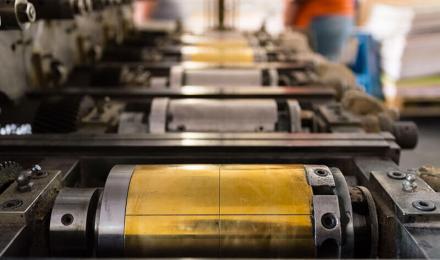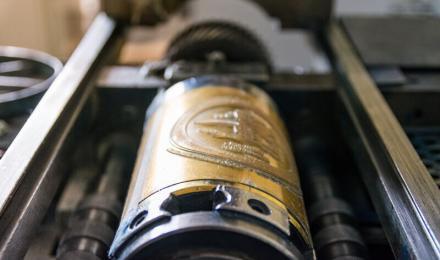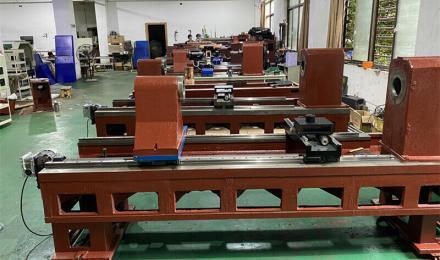Plate Rollers, Plates And Overprinting
In the printing world, it is often said that the seven-point edition is printed in three parts. It can be seen that a set of good-quality plates is very important for the success or failure of printing quality. Inaccurate overprinting in printing is often occurring. About inaccurate overprinting and poor overprinting, the reasons are more complex, mainly involving the machine and printing materials. The machine part can be divided into machine overprinting registration device, tension, oven temperature, plate making, plate loading, pressure roller, guide roller, cooling roller, and many others.
In the national standard GB/T7707-2008 gravure decoration printing, the overprint error requirements for double-stretched plastic film printing are: the allowable error of overprinting the main part is ≤0.20mm, and the allowable error of overprinting of the secondary part of the print is ≤0.35mm.
Some overprinting errors can easily be judged from the mark line and overprint arrows on the printing plate. But many of the reasons for it are a result of quality errors in the printing plate cylinder. But this is yet to attract much attention.
Printing Plate Roller:
- The production of printing plate roller
The gravure printing plate is not pre-made and installed on the plate table or printing plate cylinder. It is directly on the plate cylinder, and then the plate cylinder is installed on the printing machine for printing.
Therefore, the selection of a gravure cylinder should be good. The processing should be refined; the printing plate cylinder has an open hollow cylinder and a closed solid cylinder. The length and circumference of the cylinder have more to do with the size of the gravure printing machine. In addition, the size of the printed matter is also a factor.
The gravure plate roller processing can be directly with seamless steel pipes. It can also be rolled into a cylinder with a steel plate for welding and then processed. It is best to use a seamless steel pipe for direct processing of the cylinder. The inner wall of the seamless steel pipe is smooth and interfaceless. For version roller, the wall thickness must be uniform, and the indicators should meet the quality standards.
The processing of the drum is divided into three processes: rough processing, semi-finishing, and finishing. Rough machining makes the wall thickness of the drum meet the specified requirements. This is to ensure that when the drum rotates, the weight of each part is consistent. The centrifugal force generated during engraving and printing rotation is also the same. Semi-finishing is the process of keeping the shaft concentric with the drum. Finishing is the outer circle of the finishing car drum to bring it to the size specified by the design. Only the finished drum can enter plating and engraving.
The processing accuracy of the printing plate cylinder is directly related to its service life. It is also related to the electroplating and engraving effect of the plate cylinder and the final product printing quality. After processing, the wall thickness must be uniform. The different centricity of the shaft and the outer center of the drum cannot exceed 2μm. The surface finish of the drum should reach Δ5, and the cylindrical grinding machine should reach Δ7 or more after processing, and the diameter accuracy error is ±0.01μm.
- Several items in the printing plate should pay attention to the value of control:
1)Tolerance ¢600h5(-0, 020, 0) in diameter direction, roundness tolerance +-0.01mm for the outer circle of the printing plate
2) The coaxial tolerance of the outer round face of the printing plate and the journals at both ends is +_0.02mm
3) Tolerance of journal and journal sleeve: ¢45 H6/h5, dynamic balance less than 50g (high-precision printing plate less than 30g).
4)Plug: outer diameter 98mm, inner diameter 84mm, taper 10 degrees, keyway 14×4.5
5)Mark line: Mark line width 1mm×5mm, spacing 20mm, mark line distance printing edge 1mm, last mark line distance printing direction 80mm, detection line distance printing edge 3mm, detection line width 2mm.
- Plate Plating:
The electroplating of the printing plate drum should be fine. The copper layer should meet the standard. Also, the oil stain treatment on the surface of the plate drum should be before copper plating. Finally, a layer of nickel is plated on the surface of the drum. Then copper plating is quite important. The copper layer is the engraving layer of the gravure plate cylinder, and an electronic engraving machine completely carves the graphic part of the printed matter on this layer. The quality of copper plating is directly related to the quality of the engraving of graphics and text.
- The basic requirements for thickness and hardness of electroengraving printing plates after plating:
1)Electric engraving plate plating. Generally, the thickness of the nickel plating layer of the electric engraving plate is 10um. The thickness of the copper plating layer is 60um (the depth of the field engraving is 40um). Lastly, the chrome plating layer is 10um.
2)Hardness of each layer of the printing plate. The surface hardness of the copper layer is 100~120 Vickers. The hardness of the chrome plating layer is 1100 Vickers.
3)Mesh depth. The surface of the micropores of the electric engraving plate is 15um~100um in diameter. Its depth is between 5~50um, and the general field plate mesh depth is about 35um.
4) For the copper-plated drum, the surface of the copper layer needs to be ground to make the surface finish of the drum reach ▽8~▽10.
- Plate barrel quality and plate loading:
1) The problem of plate making, such as the plate roller is not round, the shaft core line is not straight when rotating after the determination of the color order, the increase in the diameter of the plate is not appropriate, the diameter of each plate is generally 0.02~0.03mm (empirical data), the role of the increase in the diameter is to compensate for the loss of mechanical synchronous speed caused by resistance and pressure during the film forward.
2) The reason for plate loading is usually that the keyway and the plug do not match. The plate roller will jump during operation, resulting in an uneven force on the film in the traction forward. The circumferential run out of the printing plate will cause irregular changes in film tension and varying degrees of change in the length of the entire printing path, resulting in inaccurate nesting. When loading, it is necessary to ensure that the cone holes and solid cone at both ends of the printing plate roller are clean.
3)A major feature of the gravure printing process is the circular pressing process. The printing plate roller diameter difference is poor, or the printing plate is not arranged in increasing order. Coupled with the characteristics of material elongation in flexible packaging printing, in order to eliminate the elongation of the material and ensure the accuracy of overprinting of flexible packaging materials. Generally, the roll increases by 0.02mm per color according to the color order (past experience value).
4) The diameter of the printing plate is beyond the set range of the machine, too large or too small, or the mark line setting is abnormal.
Regarding The Inaccuracy Of Overprinting:
Generally, there are various reasons for the inaccuracy of plastic film flexible packaging overprinting. The more frequent problems of vertical and horizontal overprinting are more common:
- Longitudinal overprinting is not accurate:
1) The longitudinal thickness of the printing material is not thick, or there is a ruffle phenomenon. A printing material left and right sides of the thickness difference of 5% may produce the phenomenon of inaccurate sleeves on the left and right sides. The most intuitive is that the material in the machine collapse can observe whether the material has longitudinal thickness phenomenon, some places called ruffles, swing edge phenomenon. This phenomenon with a thickness gauge is difficult to measure and can only rely on the physical object directly judged.
2) The setting of the speed of the three rollers is improper, the surface friction decreases, and the three rollers generally refer to the printing plate pressure roller, printing plate roller, and guide roller. Everyone knows that if the speed between the three rollers is not consistent, tension instability will occur, the material will shake when walking, and the overprint will be inaccurate
3) Improper adjustment of hot and cold air causes material deformation or softening due to moisture absorption of the material, and stretching affects the accuracy of overprinting.
4)During the production of the printing machine, due to the instability of the traction and winding tension caused by the amount of roll stock, the longitudinal overprinting is inaccurate.
- Horizontal overprinting is not accurate.
1) The tension of the film changes and forms a left and right swing, resulting in inaccurate lateral overprinting.
2) The film is loose on one side, resulting in snake thread running. or a depression in the middle, etc.
3) The printing plate roller or the printing pressure roller does not have the central roundness, forming a conical shape, and the circumference of left and right circumference of a roller cylinder is 5um apart, which may produce overprinting inaccuracy.
Third, Gravure Group Printing Plate, Plate Loading Several Points Of Precautions:
- When loading the plate, pay attention to checking whether the plate shaft meets the size requirements. Also, pay attention to checking the balance of the printing plate. Whether the keyway and the plug match, whether the plate roller will jump during operation, and if the plate jumps during operation. It will bring the uneven force of the film in the traction advance and affect the overprinting accuracy.
- Control the quality of the plate roller to avoid quality defects. Check for the plate roller is not round and the shaft core line not being straight when rotating on the machine. which will affect the overprinting accuracy. The influence of plate roller processing accuracy on film overprinting is obvious. The main indicators of the machining accuracy of the printing plate roller are circular runout, coaxial (center) degree, roundness, the taper of the cone hole, etc.
- In the early stage, the gravure plates were all seamless steel pipes. The roller substrate was thick, with balanced thickness and pressure resistance. At present, many plates use iron-clad sheets, and the thickness of the tin plates varies from 4.5mm ~ 1.2mm. This causes the uneven quality of the current plate roller plates. It directly increases the difficulty of gravure printing and affects the printing quality of the film.
- Because the tensile strength of various plastic films is not the same. After printing, the tensile rebound rate is not the same after the determination of the printing color order. According to the printing color order, the diameter increase should be appropriate. The role of the plate diameter increase is to compensate for the mechanical synchronization speed loss caused by resistance and pressure in the process of the film forward.
- At present, the machine speed is relatively fast, and when the speed exceeds 120m/min on the medium and high-speed gravure printing machine, the overprint mark can no longer reduce. Otherwise, it is easy to misalign the membrane, which will outweigh the loss.
- The drying form is volatile drying, so there are different solvents corresponding to the ink types of different resins. There should be a strict distinction between real solvents and false solutions to avoid quality failures caused by ink problems.
- As we all know, one of the most important characteristics of gravure plastic printing is the round pressing round production process. This is the film thickness between entering the printing plate, and the pressure roller must be basically the same. If the film thickness is too different on the left and right sides, the speed of entering the printing plate is not the same. Therefore, it is very important to choose the thickness and thinness of the film, especially paying attention to the uneven thickness of the longitudinal thickness, and the probability of overprinting inaccuracy is higher.





